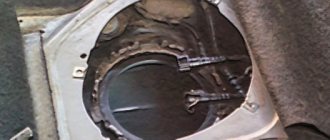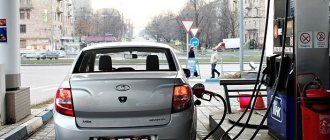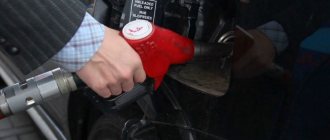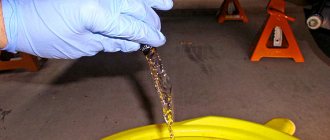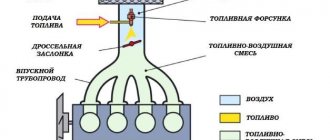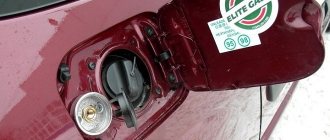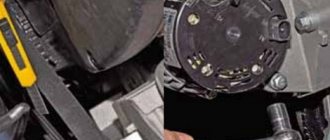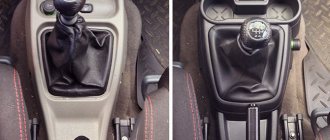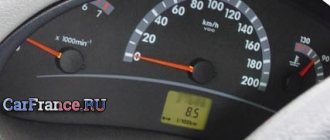Draining gasoline from a gas tank is an event that is faced not only by lovers of easy money.
The quality of fuel in Russia is such that even a trustworthy and honest motorist may encounter such a need.
What kind of gasoline should I put in the Lada Granta?
A drop in engine power, erratic operation, extraneous sounds, an unpleasant odor, a changed color of exhaust gases - many symptoms indicate that low-quality fuel was poured into the gas tank.
Operating a vehicle in such a situation is not recommended, in fact, it is even prohibited, as the risk of deposits in the fuel lines and carbon deposits forming on the valves and inside the cylinders increases.
All this is fraught with serious damage, the elimination of which will require considerable financial investments. There is only one correct solution - stopping and draining the low-quality product. How to do it? Let's find out in our article.
When does it become necessary to drain the fuel from the tank?
Fuel is drained when the motorist sees that the gas tank is full. Excess gasoline is poured into cans. The procedure is carried out when repair work is required. Situations may arise on the road when you need to provide assistance to a person whose car has stalled. In this case, fuel is pumped out of one car and poured into the gas tank of another.
The gas tank is completely emptied in the following cases:
- The fuel filter needs to be replaced.
- The pump requires replacement.
- The gas tank needs to be flushed. This need arises when low quality fuel was filled at the gas station. If it has been in the tank for a long time, it becomes clogged.
- The old tank is replaced with a new one. The need appears when the old one is damaged or worn out.
The motorist must remember that gasoline can only be drained outdoors. The fumes are poisonous and can cause you to get sick, so it is forbidden to drain it indoors. Fuel is often divided in the following situations:
- When someone stalls on the road and asks for help.
- In order to heat the car interior in a strong snowstorm. While people are waiting for the Ministry of Emergency Situations, there is not enough space in one car, they start a second one. Gasoline is poured into it to heat the interior.
- To refuel the generator. Such situations arise when the battery runs out.
To carry out the procedure, you need to have the necessary equipment with you. You should carry a hose equipped with a bulb in the trunk.
Part replacement features
Replacing this part is not so difficult if you know where the fuel filter is located on the Largus and how to carry out the repair correctly
It is important to note that even an amateur motorist can perform the replacement procedure, since the whole process is very simple. Replacing the filter does not require any serious preparation, except for the following measures:
- It is best to replace the filter element in a spacious workshop, where the car can be parked on level ground, securely fixing it with a handbrake or a wheel stand;
- prepare in advance a standard car repair kit: several screwdrivers, a set of keys, rags and gloves;
- buy a fuel pump assembly or a separate fuel pump “mesh” (for example, the same part will do, but only from Renault Logan).
The procedure itself takes no more than 30 minutes, of course, if you do not want to completely disassemble the fuel pump system and try old-fashioned methods to clean the fuel filter. Replacing the part with a homemade filter is considered a bad idea. Also, this should not be done because incorrectly cleaning or assembling the fuel pump will cause serious damage to the entire Lada Largus fuel system. Is it worth it? Most likely no.
We drain fuel from VAZ family cars
There are several ways to drain gasoline. Fuel can be drained in the shortest possible time using a hose equipped with a bulb pump. This simple device allows the car owner to remove gasoline from the tank without harming his health. But such a device can be used if the tank does not have a protective mesh at the neck.
There is a simple but effective method. Often fuel needs to be pumped out quickly; the need catches the driver on the highway. For example, this situation arises when you need to save someone. It happens that you don’t have the necessary things with you. In this case, you can use a small diameter tube.
The procedure is similar to the one that involves using a hose:
- First, negative pressure is created in the tube using the mouth. The method is not dangerous, so the car owner does not have to worry about gasoline getting inside the body.
- When the required pressure has been created, a rope is passed through the tube. It should have a smaller diameter. Its end part is tied in a knot, and the size must match the diameter of the pipe.
- The result is a homemade “piston”. It is moistened; saliva can be used for this. After this, the tube is lowered into the fuel tank. It is worth preparing a bucket in advance; gasoline will drain into it. When everything is ready, a rope is taken out of the pipe. We lower one end of it into a canister to collect fuel.
- The work must be done slowly. When the piston is completely removed, the fuel itself will flow into the canister. In order to stop the process, you need to raise part of the piston above the level of the tank. After pumping out the required amount of fuel from the gas tank, close it with a lid.
The procedure has several disadvantages, but the main one is that it is impossible to completely empty the fuel system . The procedure becomes more complicated if it needs to be performed on a machine that came off the production line after the 90s. The fuel lines in such vehicles are tortuous.
On domestic cars, gas tanks often have plugs. They are installed so that motorists can drain fuel if necessary. To do this, the car must first be jacked up. After this, place a container of suitable volume next to it and unscrew the stopper.
When working, there is no need to rush; you should make rotational movements. Before starting the procedure, the neck of the tank is opened. This makes it possible to remove the fuel completely. The method is labor-intensive but effective.
If the car is fuel injected
Motorists who drive fuel-injected vehicles should take into account that using a hose will not completely remove the fuel. Therefore, you need to open the gas tank and perform the following steps:
- Determine where the tube is located. It is located at the bottom of the engine and is necessary to supply gasoline to the ramp.
- Remove the clamp and disconnect it from the pipe.
- Turn the ignition key.
- You need to look at another relay block. You need to understand which of them is responsible for the operation of the fuel pump.
- It is removed, then you need to bridge it. To do this, use a paper clip.
- Turn on the ignition. Fuel flows into the container.
What will happen if you don't change?
The first to fail are the bearings, the failure of which can be indicated by symptoms such as noise and hum in the operation of the gearbox. Sometimes sounds appear when you turn on a certain gear. It is also possible for the speeds to switch off spontaneously. If you do not take immediate action to change the oil, the entire gearbox will fail.
Loading …
Find out more about the new Logan
- Renault Logan gearbox: device and switching diagram
- How to change oil in manual transmission Renault Logan, Sandero, Largus
- Changing the oil in the Renault Logan gearbox: procedure, recommendations
- Changing the oil in a Renault Logan box: how much and what kind of lubricant needs to be filled
- Changing the oil in a Renault Logan box: how much and what kind of lubricant needs to be filled
- What kind of oil is poured into the Renault Logan gearbox?
- Changing the oil in a Renault Logan manual and automatic transmission
- Renault Logan remove replacement repair Checking the level and adding oil to the Renault Logan gearbox
Drain fuel from a foreign car correctly
Foreign cars have a complex structure, so it is more difficult to drain gasoline from a foreign car. For example, it is removed from a Camry using a hose. But first you will have to remove the mesh that protects the neck of the tank.
The procedure is complex, so the best option when working with a foreign car is to drain the fuel not from the tank itself, but from the system through which the fuel moves.
First, the car owner must find where the fuel line runs. Beginners should not perform the procedure on their own. The container is prepared in advance; it must be clean.
There are 2 ways to carry out the drain. The first is based on the driver first disconnecting the tube that runs in front of the pump. But you need to be prepared for the fact that the canister will fill slowly, because the diameter of the tube is small.
The second method is based on the fact that the car owner opens the tubes that go after the pump. Then he starts the engine, then the gasoline drains quickly. During the procedure, fuel should not splash onto the ground.
Precautionary measures
It is forbidden to jerk the fuel hose sharply, as it may break. When working with gasoline, you must ensure that it does not get on your clothes. It can ignite if there is a spark. This requirement is important if the driver and passengers smoke. It is strictly prohibited to light a fire or smoke while the procedure is being carried out and the container is being filled.
If the driver decides to use the old method, which is based on sucking air from a hose with his mouth, he should be aware that gasoline may accidentally get inside. There is a possibility of fuel being drawn in.
If this happens, your mouth should be rinsed well with water. To avoid this, inhale a little air through the hose, but carefully. We hold its end in our hands.
Removing the gasoline pump
At first it may seem that this method is more complicated than the previous technology, but in practice it is possible to verify that this is not the case. In some ways, the removal option is even simpler, which is why many drivers choose it. So, the instructions look like this:
- The rear seat cushions recline.
- The rug is raised. The mat hides the 4 screws that secure the cover. All screws need to be unscrewed, they are tightened without much effort, so a regular Phillips-head screwdriver will do.
- The block with a set of electrical wires coming directly from the pump is disconnected.
- Removing the fuel hoses that secure the pump in place.
- A special plastic ring that presses the pump is unscrewed. This is done very simply, the ring simply rotates counterclockwise. In some cases, when the initial clamping force is too high, a flat-head screwdriver and a hammer may be needed; these tools can be used to pry up and slightly loosen the ring.
- Removing the gasoline pump. When removing, it is recommended to tilt it slightly to the side, which will eliminate the possibility of damaging the lever indicating the fuel level, as well as turning the float sensor that determines the current level.
Is it possible to protect yourself from gasoline being drained from your own car?
In order to protect your domestic vehicle, you need to close the tank with a special lid. Foreign cars themselves have a more complex structure, so such a device is not required.
It will help if teenagers are draining gasoline. They are unlikely to protect you from other criminals. Many owners, trying to protect their car from intruders, weld the neck. They carry her to the luggage compartment. This method is effective, but not good, because at a nuclear power plant the tankers will not service such a machine.
Every motorist encounters unexpected situations on the road. In some cases, it is necessary to empty the fuel tank in emergency mode. Also, draining may be relevant when refueling with the wrong fuel, it may be of unsuitable quality, or for repair work.
It is not difficult to drain fuel from a car modified in the 2000s, but with new ones the situation is more difficult. In new-style cars, a protective mesh has been introduced into the gas tank, so draining will not be easy, but there are still several ways to do it.
Design
Regardless of the factor, what kind of car you own and what tank you drain, you will still be faced with a single concept. It will not be the case that in one machine everything happens one way, and in another - according to a different method. Everything is done the same for everyone. Each fuel tank of a regular passenger car or SUV has its own capacity. Some have 20 liters, others have 100 or more. This doesn't matter at all. Each tank is closed tightly using a regular lid called a “screw” lid. Thus, fuel does not leak out of the tank anywhere and, of course, does not simply drain into the external environment. It just burns off and the internal combustion engine uses it to keep your car going on the road.
Second way
This option is more difficult. To drain the fuel, you will need to perform the following algorithm of actions:
- Open the car hood.
- With the engine off, disconnect the fuel supply hose. Disconnection is carried out where there is contact with the engine.
- The free end is inserted into the drainage vessel.
- Next, you need to turn the ignition key, but you do not need to start the engine itself.
- By “playing” with the ignition, you can drain the required amount of fuel.
It is not advisable to drain all gasoline using the described method, as there is a risk of damage to the fuel pump or airing of the vehicle’s fuel system. Tricks with closing contacts are performed solely at your own peril and risk.
It is necessary to monitor the flow of gasoline that comes in. If bubbles begin to appear in the liquid, this will indicate that there is not much gasoline left in the tank and it is time to finish, since this method has many risks.
After carrying out the described manipulations, it is important not to forget to return everything to its original place.
This is the only possible way for cars with fuel injection system. Deception of the fuel pump is an effective and only method.
Method 2. Removing the gasoline pump
There is another option that may be easier for many people. We are talking about completely removing the gasoline pump. This is done by raising the rear row seat, after which you need to unscrew the pump mounts. Next, you get direct access to the fuel, so you can pump it out using the traditional method.
This is a fairly simple procedure that does not require prior preparation. In the case of the Lada Granta, the entire fuel module will have to be dismantled.
- To do this, the rear seat cushion is folded down.
- After which the parts of the mat, previously cut by the manufacturer, are raised. Under them you will find four screws that secure the cover. They will have to be unscrewed. A Phillips screwdriver is used for this purpose.
- After this, you will need to disconnect the block with electrical wires from the pump itself.
- You will also have to remove the fuel hoses that hold the device in its position.
- Now you can carefully grasp the pump pressure ring by unscrewing it counterclockwise. For this purpose, it is recommended to use a flat-head screwdriver and a hammer, if necessary. As a result, the ring comes off easily.
- The fuel pump itself is removed by slightly tilting it to the side. This must be done in order not to damage the gas gauge sensor lever. In addition, this way you will protect the float on the lever from turning around its axis. If it is misaligned, it may result in subsequent false readings of the amount of fuel in the tank.
Direct drain option
The easiest way. To drain gasoline, you only need a hose of the required length.
In this case, you must perform the following actions:
- The end of the hose must be immersed in the car tank. Take the free end into your mouth and pull out the air masses from it.
- The second end must be lowered into a vessel previously prepared. It should be located below the fuel tank.
- After draining the required amount of fuel, raise the container to the same level as the tank or higher, and then remove the tube from the gas tank.
We drain fuel from VAZ family cars
Despite the fact that some car owners never have to drain gasoline, it is highly advisable to have the simplest and most inexpensive device for draining fuel in the trunk - a rubber hose with a bulb pump. With its help, you can quickly and safely get rid of the contents of the gas tank. This method, despite its simplicity, can be used on any vehicle whose gas tank neck does not have a protective mesh.
If the need to drain gasoline from a grant catches a driver on the road (for example, to help out a friend who has run out of gas), and there are no special devices at hand, except for a small diameter tube, you can use the following method: the principle of the method is identical to creating negative pressure using mouth, but absolutely safe for health. A rope of smaller diameter must be passed through the tube, the end of which should be tied with a knot, the size of which will be approximately the same as the diameter of the tube.
The resulting “piston” is moistened with any liquid, maybe even saliva, and the tube is lowered into the gas tank. Having prepared a container for draining gasoline in advance, you need to start pulling the rope out of the tube, lowering its outer end into the container. There is no need to rush, and you need to pull out the “piston” quite smoothly. After it is completely removed, gasoline will flow on its own. To stop this process, it is enough to raise the outer end of the tube above the level of the tank. The disadvantage of the above-mentioned methods can be considered the impossibility of completely freeing the fuel system from gasoline, especially on vehicles that came off the assembly line after the 90s - these are characterized by a thin and tortuous fuel line.
Most domestic cars have a special plug in the bottom of the gas tank designed to drain fuel. Before draining gasoline from the tank using this plug, it is advisable to jack up the car, place a container of adequate capacity, and then unscrew the plug. It is best to do this slowly, with slow rotational movements. Before this procedure, it is advisable to open the neck of the tank, which will allow all gasoline to drain without any residue. Despite the labor-intensive nature of this method, it is quite effective.
Gas tank capacity in Largus
| Options | "Universal" 7-seater | "Universal" 5-seater | "Van" | |||
| K4M/21129/ JR5 | 11189/JR5 | K4M/21129/ JR5 | 11189/JR5 | K4M/21129/ JR5 | 11189/JR5 | |
| "Luxe" | "Norma" | "Luxe" | "Standard" "Norma" | "Luxe" | "Standard" "Norma" | |
| Engine capacity | 1.6 l 16V | 1.6 l 8V | 1.6 l 16V | 1.6 l 8V | 1.6 l 16V | 1.6 l 8V |
| Number of doors | 6 | |||||
| Length, mm | 4470 | |||||
| Width, mm | 1750 | |||||
| Height without roof rails (at curb weight), mm | — | 1650 | ||||
| Height with roof rails (at curb weight), mm | 1670 | — | ||||
| Base, mm | 2905 | 2905 | ||||
| Front track, mm | 1469 | 1468 | ||||
| Rear track, mm | 1466 | 1466 | ||||
| Front overhang, mm | 795 | 795 | ||||
| Rear overhang, mm | 770 | 770 | ||||
| Ground clearance at full weight, mm | 145 (minimum ground clearance corresponds to the point under the engine mudguards) | |||||
| Trunk volume (VDA), dm3 | 135 | 560 | 2540 | |||
| Weight of the vehicle in running order, kg**, with driver | 1330… 1370 | 1260… 1345 | 1260…1275 | |||
| Permitted maximum weight (technically permissible), kg | 1810… 1850 | 1705… 1790 | 1985… 2000 | |||
| Maximum weight on the front axle (technically permissible), kg | 930 | 940 | ||||
| Maximum weight on the rear axle (technically permissible), kg | 1080 | 1160 | ||||
| Permissible total weight of a towed trailer, not equipped with brakes, kg | 650 (420 for a car without ABS) | |||||
| Permissible total weight of a towed trailer equipped with brakes, kg | 1300 | 1300 | 1300 | — | ||
| Permitted maximum weight with trailer, kg | 2650 | 2650 | 2650 | 2600 | ||
| Permissible load on the coupling device, kg | 75 | |||||
| Permissible load on the roof rack (including the weight of the rack), kg | 80 | |||||
| Maximum speed, km/h*** | 165 | 158 | 165 | 158 | 165 | 158 |
| Acceleration 0-100 km/h, s*** | 13,5 | 14,4 | 13,1 | 14,2 | 14,0 | 15,4 |
| Fuel consumption, l/100 km (combined cycle) | 9,0 | 9,5 | 9,0 | 9,3 | 9,0 | 9,3 |
| Wheels | 6.0 J15 | |||||
| Tires | 185/65R15 | |||||
| Turning diameter according to clearance, m | 11,25 | |||||
| Fuel tank volume, l | 50 |
When loading a vehicle to its full weight, the weight of the trailer should not lead to excess weight of the road train.** The curb weight indicated in this table corresponds to the weight of an empty vehicle.*** Technical characteristics are measured using special methods, serve for comparison of different vehicles and operating standards they are not!
| Options | "Universal" 7-seater | "Universal" 5-seater | "Van" | |||
| K4M/21129/ JR5 | 11189/JR5 | K4M/21129/ JR5 | 11189/JR5 | K4M/21129/ JR5 | 11189/JR5 | |
| "Luxe" | "Norma" | "Luxe" | "Standard" "Norma" | "Luxe" | "Standard" "Norma" | |
| Engine capacity | 1.6 l 16V | 1.6 l 8V | 1.6 l 16V | 1.6 l 8V | 1.6 l 16V | 1.6 l 8V |
| Number of doors | 6 | |||||
| Length, mm | 4470 | |||||
| Width, mm | 1750 | |||||
| Height without roof rails (at curb weight), mm | — | 1650 | ||||
| Height with roof rails (at curb weight), mm | 1670 | — | ||||
| Base, mm | 2905 | 2905 | ||||
| Front track, mm | 1469 | 1468 | ||||
| Rear track, mm | 1466 | 1466 | ||||
| Front overhang, mm | 795 | 795 | ||||
| Rear overhang, mm | 770 | 770 | ||||
| Ground clearance at full weight, mm | 145 (minimum ground clearance corresponds to the point under the engine mudguards) | |||||
| Trunk volume (VDA), dm3 | 135 | 560 | 2540 | |||
| Weight of the vehicle in running order, kg**, with driver | 1330… 1370 | 1260… 1345 | 1260…1275 | |||
| Permitted maximum weight (technically permissible), kg | 1810… 1850 | 1705… 1790 | 1985… 2000 | |||
| Maximum weight on the front axle (technically permissible), kg | 930 | 940 | ||||
| Maximum weight on the rear axle (technically permissible), kg | 1080 | 1160 | ||||
| Permissible total weight of a towed trailer, not equipped with brakes, kg | 650 (420 for a car without ABS) | |||||
| Permissible total weight of a towed trailer equipped with brakes, kg | 1300 | 1300 | 1300 | — | ||
| Permitted maximum weight with trailer, kg | 2650 | 2650 | 2650 | 2600 | ||
| Permissible load on the coupling device, kg | 75 | |||||
| Permissible load on the roof rack (including the weight of the rack), kg | 80 | |||||
| Maximum speed, km/h*** | 165 | 158 | 165 | 158 | 165 | 158 |
| Acceleration 0-100 km/h, s*** | 13,5 | 14,4 | 13,1 | 14,2 | 14,0 | 15,4 |
| Fuel consumption, l/100 km (combined cycle) | 9,0 | 9,5 | 9,0 | 9,3 | 9,0 | 9,3 |
| Wheels | 6.0 J15 | |||||
| Tires | 185/65R15 | |||||
| Turning diameter according to clearance, m | 11,25 | |||||
| Fuel tank volume, l | 50 |
If the car is fuel injected
It is absolutely impossible to completely empty the fuel system of an injection car using a hose. Therefore, in order to drain gasoline from an injection VAZ 2110, you will need to take a different route. First, you need to open the gas tank itself (neck), after which the algorithm of actions will be approximately as follows:
- find the tube located at the bottom of the engine that supplies fuel to the ramp;
- remove the clamp from it and disconnect it from the pipe;
- turn the ignition key;
- in the relay block, determine the one that is responsible for the fuel pump;
- after removing it, you need to bridge it, for which it is convenient to use a standard paper clip;
- turn on the car ignition;
- Drain the leaking fuel into a prepared container, then return the hoses and relays to their places.
Draining gasoline through the pump hatch
The option described in this subsection will not allow you to completely drain all the gasoline in the tank. However, it is much safer than the above, although the procedure itself takes noticeably longer.
In this case, the fuel is removed while located directly in the cabin. This is best done in the fresh air and with the doors open.
Take all precautions:
- do not smoke;
- turn off the power;
- do not wear clothes made of synthetic fiber;
- Make sure you have a fire extinguisher at the ready.
During operation, quite a lot of gasoline vapor is generated, which in the limited space of the cabin can simply ignite. Be sure to ask someone to cover you just in case.
The procedure is as follows:
- remove the back seat from the interior;
- open the hatch located underneath;
- remove the power terminal from the fuel pump;
- after unscrewing the bolts, carefully pull out the assembly (be very careful with the float - it breaks easily);
- remove the pump;
- pump out the fuel through the opened hole using a rubber bulb;
- Upon completion, return the unit, hatch and seats to their place and thoroughly ventilate the interior.
Drain fuel from a foreign car correctly
If everything is more or less clear with domestic cars, and the question of whether it is possible to drain gasoline from a viburnum can be considered rhetorical, foreign-made vehicles are more complex, and in order to drain gasoline from the tank of a foreign car you will have to work hard. Before draining gasoline from a Toyota Camry using a traditional hose with a bulb, you will have to remove the protective mesh from the neck of the gas tank, which performs an important protective function by preventing foreign objects from entering the tank. This procedure is not an easy one, so on a foreign car it is best to drain gasoline not from the tank, but through the pipeline directly into the fuel system.
To do this, the pipeline must first be found. For inexperienced drivers, it is better to use the vehicle’s operating instructions or enlist the support of more experienced comrades. Before draining gasoline, it is necessary to prepare a clean container, the volume of which is guaranteed to be sufficient for all the spilled fuel. In this case, you can go in two ways. If you disconnect the tube located in front of the pump, fuel will pour out for quite a long time - the small diameter and tortuosity of the pipeline will affect it. If you disconnect the pipes after the pump and start the engine, all the gasoline can be drained as quickly as possible. If for some reason you need to drain gasoline from the tank of a foreign car, there is nothing left to do but remove the protective mesh.
FakeHeader
Comments 21
The tank is exactly 50 liters - tested on a stalled car by filling it up to the neck. And they simply inject you with gasoline. All tanks are the same, because... in the molds of a part such as a tank, there cannot be an error of more than 100 grams.
After a full tank, when the first light goes out
somehow I didn’t notice, but if on the highway it takes a very long time, and then abruptly. This is an incorrect operation of the on-board driver. just like when parking on a slope or with the car running, refuel.
I've driven 200 km through the city in Japan and not a single stick has fallen yet
The tank is exactly 50 liters - tested on a stalled car by filling it up to the neck. And they simply inject you with gasoline. All tanks are the same, because... in the molds of a part such as a tank, there cannot be an error of more than 100 grams.
Golimaya nonsense, the tank on the Largus is under the throat, about 65 liters, I measured it myself with a canister!
It’s strange, when I have 9-10 liters left (according to BC), 40 liters can hardly fit in. If the remainder is 11, then about a liter does not fit, it snaps off and flows from the neck along the wing.
